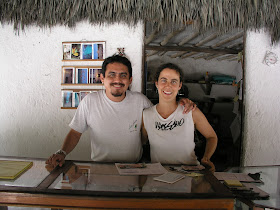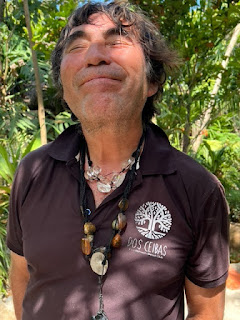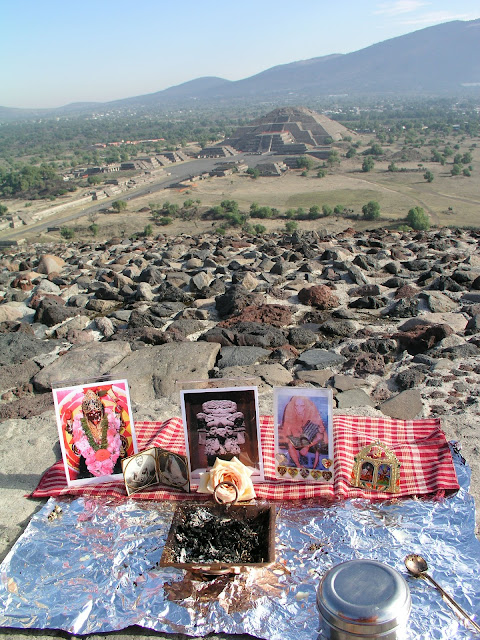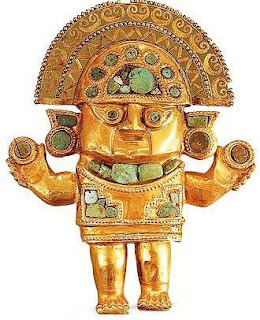बुद्धिहीन तनु जानिके, सुमिरौं पवन कुमार |
बल बुद्धिविद्या देहु मोहिं, हरहु कलेश विकार ||
buddhi hīn tanu jānike, sumirauṁ pavan kumār |
bal buddhi vidyā dehu mohiṁ, harahu kaleś vikār ||
“Realizing the inadequacy of my intellect, I meditate on you, O Hanuman, the son of the wind-god; grant me strength, intelligence and true knowledge, and remove all my afflictions and blemishes.”
-from the doha of the Hanuman Chalisa
Lord Hanuman in Mexico
On a full moon night in 2005, Hanuman appeared before us on a white sandy beach in Quintana Roo, Mexico. He stayed with me for 17 years. Though he was always near me, I never fathomed the extent of his presence until he was gone one recent morning on the same beach, just further south.
During these 17 years many extraordinary things happened, in which I had a role to play. Though the actions I felt compelled to do were perhaps unusual, they didn’t feel that much out of the ordinary. In retrospect, however, the realization dawned on me how some of the things I did in good faith should, in actuality, have been next to impossible to carry out. While I contributed my sincerity, Lord Hanuman provided the magic.
I have always had a deep feeling for ancient peoples and cultures. When I was a child growing up in Vienna, Austria, I got so mad when I read about the massacre of the Incas. I cut my finger and dripped a few drops of blood on the history book, vowing to set things right. As one ages, one learns that you can neither change history nor the nature of mankind.
To explain the story of Hanuman’s appearance in Mexico, I need to give a bit of history on what led up to the event. In the 1970s, I fell in love with a photograph of Sri Ramakrishna at the Hollywood Temple of the Vedanta Society.
It took some time, but my love for Sri Ramakrishna and some hard knocks of life were able to reduce my ego and prepare my heart for surrender. Countless pilgrimages to holy places in India gave me a taste for divine experience.
By the year 2000, I was all set to go to Mount Kailash in the Himalayas, eager to perform a homa, a sacred fire ceremony, on top of the world for the welfare of all. My friend Nandu helped me by teaching me how to perform a simple homa. I practiced the mantras, bought the necessary items and was ready. Days before departure, I received a call from the Nepali travel agent. My trip was cancelled, but the momentum for going on a pilgrimage and performing a homa remained very strong.
This turned out to be fortuitous as the momentum brought me south of the border and made me fall in love with Mexico. For some time, I had wanted to visit the Basilica of Our Lady of Guadalupe but had always hesitated because of language problems. As luck would have it, Swami Bhajanananda, who speaks fluent Spanish, had just returned from India and offered to accompany me.
The feeling one gets in Mexico is similar to what one experiences in India. Magic episodes seem quite normal. I woke up early in my hotel room in Mexico City to a voice talking in my head. Though this is rather unusual, it didn’t seem so at the time. The voice spoke English like a newscaster, and lying on my queen size bed under crisp, white sheets, I listened to a running commentary on historical and modern events in Mexico gone wrong. I could have switched off this voice, telling myself not to give in to crazy notions like listening to a voice in my head, but I didn’t because the things the voice said made sense.
My plan was to go first to the Basilica of Our Lady of Guadalupe. Instead, circumstances first brought me to the National Museum of Anthropology that houses treasures recovered from the Olmec, Aztec and Mayan civilizations. Some of Mexico’s most powerful gods live there, and sadly, they are referred to as historical. What would visitors do if they could see all these gods and goddesses come alive?
Though the Basilica was the next place to visit, fate took me instead outside Mexico City. In awe, I stood at Teotihuacan, a vast archeological site with a soaring sun pyramid and a huge moon pyramid linked by the wide Avenue of the Dead. The people who built Teotihuacan had kept God in the center of their lives and activities to build their city around pyramids and temples
After Teotihuacan, I did visit
the Basilica and stood in silent wonder underneath the miraculous picture of
Our Lady of Guadalupe, the savior of indigenous Mexicans. 
Our Lady of Guadalupe
When you have an open mind, the land of Mexico speaks to you just like the sacred land in India. Mexico first showed me its past glory and then brought me to its modern Basilica.
After Mexico City, Swami and I flew to Quintana Roo to spend a couple of days on the beach at an eco-lodge called Kailuum. Hoping to perform a homa on the beach, I brought with me the ingredients I had gathered for Mount Kailash. It would have been awkward if I would have performed the homa when Swami, who is more adept in performing rituals, was present. While Swami performed the fire ceremony, I marveled at fate. Instead of being high in the mountains at Kailash, I was in Kailuum on the beach watching sacred flames carry prayers to God.
Years went by, but the feeling that I did not fulfill my intent for performing the homa in 2000 lingered. Five years later in 2005, my friends Debra, Kalyani and Theresa agreed to accompany me to Kailuum. We planned to perform a homa on the white sand close to the ocean on the full moon night of Hanuman Jayanti.
For that reason, I chose to bring a picture of Hanuman as the deity to be worshipped.
It was not just any picture. A devotee once brought this picture of Hanuman to Kali Mandir, claiming it to be a photo of the actual Hanuman and not a painting.
I used a standup plastic frame for holding up Hanuman’s picture in the sand.
When the frame looked too plain, I decorated it with some devotional stickers my friend Guru Bhakti had given me from the local Hare Krishna Temple.
Kailuum, which unfortunately no longer exists, was a magical place.
We slept in army tents under palapas. With the exception of the communal bathroom, there were no hard floors in Kailuum, only white sand.
No electricity, only candles and torches. We dined by candlelight and watched the stars at night.
I had brought the finest ingredients for the homa: ghee, incense and samugri containing nuts, herbs, powders and fragrant resin. The Kailuum office staff kindly offered to supply the wood.
 |
| Kailuum office staff |
 |
| Wood stacked for bonfire |
It was the full moon night of Hanuman Jayanti. We were excited. In the early evening hours, I kept practicing the homa fire mantras Nandu had given me. Around 9 pm, the four of us walked on the beach to the designated place for the fire. As we passed the last palapa, we saw a big bonfire, already lit. The friendly people at the office obviously misunderstood. What to do? They tried to be helpful by lighting the wood intended for the homa. Little did we know that this “perceived mishap” catapulted our plan for a homa into a miraculous event.
Making the best of a disappointing situation, we dug a hole into the sand and gathered as many twigs as we could find on the beach. I prayed to Lord Hanuman to keep our small fire going until I finished the homa mantras.
 |
| Usha, Kalyani and Debra |
The full moon was up, shining brightly on a calm ocean. Everything was still, only the fire was making crackling sounds. I completed the homa mantras – I could read them well due to light coming from the big bonfire -- and we offered all ghee and fragrant items into the fire. Jai Hanuman!
Hours passed. The big bonfire had gone out some time ago, but our little fire was still burning brightly.
 | |
| Our little homa fire still burns while the big bonfire in the back is almost out. |
Every time we thought the fire had gone out and bowed to leave, a flame soared up again. We left the site around 1 am with the homa still smoldering. Theresa asked the nearby guard not to extinguish the fire but to let it burn out on its own. The guard consented to watch the sacred fire place.
The first thing I did when I got up the next morning was to walk to the homa fire site. Theresa was already sitting there meditating. There was still smoke coming from our homa. Kalyani, Debra and I went for a late breakfast and a swim in the turquoise green waters of the ocean. When we met Theresa in the afternoon, she told us that our homa fire did not stop smoldering until 2 pm. It was a miracle. How can tiny twigs burn for 17 hours?
Back in the U.S., Hanuman’s picture sitting on the chest of drawers next to my bed kept reminding me of the twigs that miraculously burned for 17 hours. Puja works. Prayers work. I got the idea in my head that worship of the ancient gods would restore Mexico’s ancient glory. I became convinced that Mexico would rise up if Mexicans would start worshipping their ancient gods in addition to their beloved Lady of Guadalupe.
Eager to get started with worship, I felt called to perform a homa on top of the Sun Pyramid at Teotihuacan for the welfare of Mexico and its people. In 2007, my friend Jayashree agreed to accompany me to Mexico City. Our driver dropped us off at Teotihuacan early in the morning, and we climbed up the steps of the great Sun Pyramid. I carried a homa kund, firewood, ghee, samugri, foil to protect the ground from stains and pictures of deities. Jayashree carried an umbrella to block the wind from blowing out the fire. Once on top, I created a small altar with pictures of Our Lady of Guadalupe, Coatlicue, Ma Kali, Sri Ramakrishna and Holy Mother. The picture of Hanuman we had worshipped in Kailuum was also on the makeshift altar.
The
homa was great. The Sun Pyramid, being a
power spot, allowed me to slip easily into intense focus of prayer. Pouring oblations into the fire for about an
hour, I prayed to wake up the Ancients so they may do good for Mexico and its
people. There was no evidence of a fire
left behind when we descended the steep steps of the pyramid.
Top of the Pyramid of the Sun at Teotihuacan with a view of the Pyramid of the Moon
Once we got back down, our driver did mention to us that he saw smoke rising from the top of the Sun Pyramid, something he had never seen before.
I wouldn’t call the homa itself a miracle. What was miraculous was that we were able to complete a fire ceremony on top of Mexico’s national monument. At that time, I did not attribute this miracle to Hanuman even though his picture was on the little altar right in front of me. I thought that I got away with performing the ceremony because I hadn’t done it for myself.
The memory of my childhood’s vow to avenge the Incas had stayed with me. When an opportunity presented itself in 2012 to enroll in a Texas University Faculty-sponsored trip to Machu Picchu, I jumped on it. Against all odds I felt confident that somehow I could perform a homa at Machu Picchu for the welfare of Peru and its people. My friend Debra joined me on this pilgrimage. On the day before Summer Solstice, we reached our hotel in Aguas Calientes, a small town at the foot of the mountain that leads to Machu Picchu. The group leader found a guide who agreed to find a place on Machu Picchu where I could perform a homa on Solstice, the holy day of the Incas.
It was still dark when we met our guide early next morning at the bus station. My heart was pounding with excitement, hoping to see the first rays of sun rise over sacred Machu Picchu. Amid a crowd of people, we stumbled up steep steps in the dark just to reach the hill above Machu Picchu as the first rays of the sun peeked over the mountain. Everybody came to a halt, clapping, shouting and applauding the sun.
As people streamed toward the ruins of Machu Picchu, the guide took us on a side path that led to the famous Inca bridge. There, hidden from view by gigantic rocks, I erected a small altar with pictures of Ma Kali, Coatlicue, Sri Ramakrishna and Holy Mother. Since I did not have a picture of the Incan Sun God at the time, I used a picture of the Hindu Sun God. The picture of Lord Hanuman we had worshipped in Kailuum was also on this altar.
Usha and Debra performing a homa at Machu Picchu on Solstice
At last, I was about to fulfill my childhood promise made to Peru. Excitement, high altitude, the potent time of Solstice and the powerful energy vortex of Machu Picchu quickly transported me into an intense state of prayer. For almost two hours, I forgot time and myself and became one with mantras, slokas and prayers to the ancient gods of Peru. May Peru and its people rise up and regain their ancient glory. I felt incredibly relieved after the ceremony was finished.
Lord Hanuman’s picture was right in front of me, but I did not attribute to him this miracle of performing a homa on Machu Picchu on the most sacred days of the Incas.
Unbeknownst to me, our guide had takem pictures during the homa and afterwards no longer treated us like tourists. He used his stick to dig a hole in the ground and buried the ashes of the homa near the rocks. He also asked if he could keep the picture of Ma Kali for his altar and give the homa kund to the local shaman.
Though I was not aware at the time, Lord Hanuman was with me for two more homa fires that came up unexpectedly.
In 2009 Rampriya Das and I went to Joydev Mela held at the village of Kenduli in the Birbhum district of West Bengal. We met with Haradhan Das Baul, a traditional Baul singer I had known for over 20 years. Traditional village Bauls are mostly poor, while sophisticated artists, who sing Baul songs to entertain well-heeled audiences, receive plenty of income. To the Bauls, singing is their sadhana. When they perform their mystic songs, they really share their sadhana with the listener.
It was Makar Sankranti and Haradhan asked me if I would be willing to perform a homa at 2 am at the Kenduli cremation ground. The famous tantric guru, Jai Shankar Baba, who used to do a homa every year on that night, had passed away just a few days before. Since nobody else had stepped forward to continue this tradition, I consulted with Rampriya and we agreed to do a simple homa. I had no book with mantras and no ritual utensils. Haradhan brought ghee, ganja instead of samugri, and he found some wood in the cremation ground. I had asked a village lady for uncooked rice for offering to the fire. Instead, she handed me a pot with cooked rice and a small spoon.
The cremation ground was quiet though, there were hundreds of people up during the night on the Mela grounds. We sat facing a small temple whose doors had been shut for the night and repeated the Shiva mantra while pouring ghee and spooning cooked rice into the fire. Once the fire had died down, glowing embers appeared like the three eyes of Ma. “Haradhan, bow down,” I said. “Ma has come.” As Haradhan made his pranams, I shouted, “Baul jago! Baul arise!”
At that instant, a tremendous gust of wind rattled the temple doors, tossed branches from trees and whirled around our heads. The three of us got quite startled, considering this happened late at night in a cremation ground. Though I should have thought of Lord Hanuman, who is the God of Wind, he was not on my mind at the time. Our fear of the wind turned into joy as soon as the first large drops of rain fell on us. The sky showered blessings on the homa. In fact, we got drenched by sheets of rain as we made a run for the next tent in the Mela grounds.
I had made plans with my friend Debra to travel to New Mexico in 2020 where I hoped to perform a homa at Chaco Canyon for the welfare of native American Indian nations. The stars were in an auspicious alignment at Summer Solstice, and I thought it would be a good time for intense prayer. Unfortunately, Covid happened, and we had to cancel our trip. I performed the homa on Solstice at Kali Mandir. It wasn’t quite as dramatic as it might have been at Chaco Canyon, but, nevertheless, it was intense. From the bottom of my heart I prayed for the Ancients to rise and do good for native American peoples.
Were my homa fires effective? Did the ancient gods hear my prayers? They say that even a butterfly flapping its wings has an effect. The mathematician Edward Lorenz came up with the term “Butterfly Effect,” a metaphor meant to demonstrate that small events can lead to significant results over time.
In Mexico there is now a new temple to Lord Hanuman and one to the goddess Coatlicue at Jamadi outside of Queretaro.

Naren worshipping Hanuman at Jamadi, Mexico

Pablo, Marisela, Lopa and Naren

The new Cuatlicue temple at Jamadi
 |
| Pablo and Marisela, proprietors of Jamadi |
I like to think that, in some remote way, my prayers had helped with their establishment. The large statue of Hanuman was created by a Mexican artist. The temples are run by Mexicans, and the devotees who worship and chant are Mexicans with occasional guests visiting from other countries.
Hanuman is no stranger to Mexico. According to Hindu mythology, he went through a tunnel in search of Sita, Lord Rama’s wife. Hanuman went straight through the Earth and came out on the other side, which some Hindus believe is somewhere in Mexico or Guatemala. This explains why Hindus have visited the Mayan ruins of Copan, located deep in the jungles of Honduras near the Guatemalan border. A monkey deity that looks somewhat like Hanuman stares at you at the entrance.
 | ||
| Monkey Deity at the Mayan ruins of Copan, Honduras |
Most visitors to these parts of the jungle are explorers, adventurers and archeologists. They are looking for the fabled “Lost City of the Monkey God” where it is rumored that a giant statue of a monkey is buried amid gold and treasures. They’ve been looking for this city since the time of the Spanish conquistadors, but to this day, this city has never been found.
The picture of Hanuman we worshipped at Kailuum in 2005 had come along with me during all my travels. It was always one of the holy pictures I carried. We often take something for granted and don’t appreciate it enough until it’s gone.
Debra and I recently went back to Quintana Roo in 2022 and stayed for a week at a charming bungalow close to the beach. On the morning before our return to the U.S., I was lying in bed, listening to the song of myriad tropical birds. Suddenly, a thought that felt more like a command hit me. I should get up and hand over the picture of Hanuman to the gardener who worked at the eco-hotel. This picture had been with me for a long time, and I thought I was okay with letting it go.
The sun had just come up over the ocean as I reached the beach and saw the gardener raking seaweed off the white sand. I walked over to him and, since I don’t speak Spanish, I just pulled Hanuman’s picture halfway out of the red silk bag and showed it to him. Pointing at the picture, I said: “This is the monkey god.” The gardener looked at me, and then looked at the picture. Without a word, he took Hanuman’s picture, put it back into the silk bag and walked off with it.
 |
| The gardener |
I was shocked that this transaction happened so fast. The picture of Hanuman I had traveled with was gone at an instant. I had to hold back my tears. How did I not know that I was so intimately attached to this picture? I could have asked the gardener to give the picture back, but in my heart I knew that I was supposed to let it go.
Back in the U.S., dwelling on this incident, I suddenly realized that Hanuman Jayanti had just passed when we were in Mexico. I realized that from our first homa in 2005 which burned for 17 hours – almost to the day – Hanuman’s picture had been with me for 17 years. Hanuman came to me on the sands of Quintana Roo, and he left me on the sands of Quintana Roo.
Now that this picture of him is physically gone, I’ll just have to see Hanuman in my heart. The essence of God can only be understood by the heart. The brain just fills in the glamorous details.
I
finished this article last night and realized it’s Summer Solstice today: June 21, 2022.




















Jai Hanuman
ReplyDeleteCoincidently June 21, 2022 is International Yoga Day! Lord Hanuman Ji is one of the Shiva's incarnation.
ReplyDeleteShiva, the first yogi (Adi Yogi), is said to have begun imparting the knowledge of yoga to the rest of mankind on this day, and became the first guru (Adi Guru). https://en.wikipedia.org/wiki/International_Day_of_Yoga